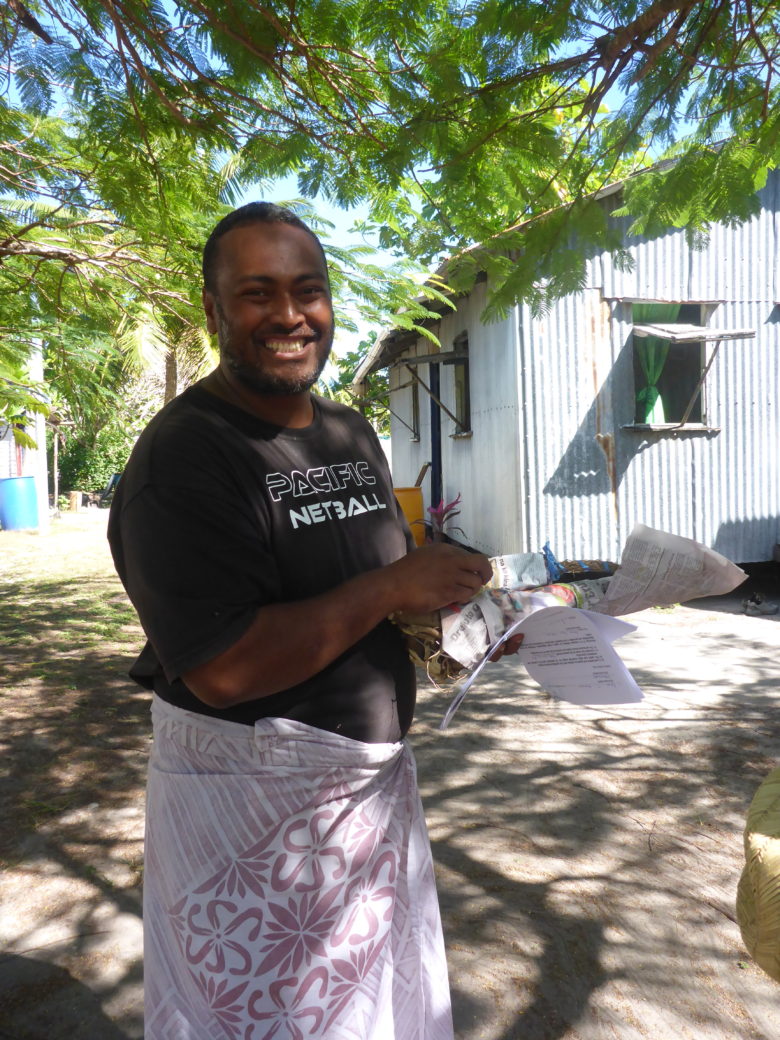Around the Top to Balavu Harbour – 17:11.23S 179:00.5W
The day after Tregoning’s departure, the big hole her absence left in our vista was suddenly filled with the luxury Motor Yacht Dardanella who literally crept over where Tregoning had been anchored as she followed her rib pilot vessel past us just a few metres away for there was no more room, and into the bay at the end. She dropped her anchor just before the shallow pass.
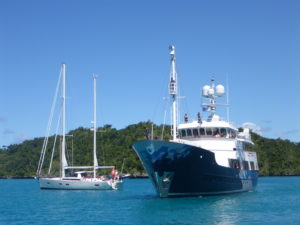
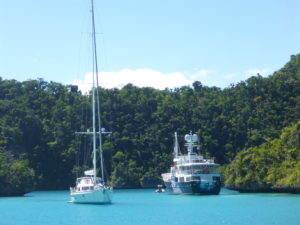
Suddenly the prehistoric aura of our surroundings was brought into the 21st century and with her and seven other yachts we felt crowded out. Wavelength had already left and we decided to do so the next morning. But first one last snorkel around our own area that we had not yet visited.
Randall said the giant grouper fish feed simply by opening their mouths and sucking in the adjacent water but I wondered if they had an endearing but deadly smile that would suddenly become a fatal view of their stomach to the unwary. We saw them hovering underneath the overhanging outcrops of coral near the reef bed and they were about 2 foot long and can grow to 2 and a half metres. My friends the AJ Mackerel were behaving like a highly trained assault team, their ever open mouths scooping up tiny young fish.
After our showers we went on a little cruise in the tender ostensibly to explore the bay where the Dardanella, registered in Georgetown, Caymen Islands was anchored, her little flotilla of kayaks and paddle boards floating behind her. The crew were friendly to the point of hellos but no more so we ‘coincidently’ crossed paths with one of the lady passengers out for a paddle. She was having a lovely time and they would be moving on to Fulanga the next day. Another name to add to my Google list ‘Dardanella’.
John and Wendy from Midnight Sun came aboard for drinks and it is likely we will meet them again as they keep MS in Whangarei and live on her for part of the year, the rest of their time they look after and maintain other people’s yachts in Gulf Harbour Auckland.
Preeti from the Copra Shed Marina in Savusavu where we had been moored sent us a letter of introduction from the plantation owners, including Tony who also owns the Copra Shed and part owns another marina at Vuda. We took it ashore with us when Zoonie was securely anchored at the inner end of Balavu Harbour near a Swiss yacht, Shamal. My legs went down on their knees begging for some exercise, not having been ashore for quite a few days and they were about to get plenty.
Ravaged by Winston
This area of Vanua Balavu was badly hit by Cyclone Winston in 2016 as the denuded plantation revealed. The stumps of fallen palms remained after the trunks were cleared away and amounted to at least half of the coconut producing palms. The animals looked well cared for though. Horses, cattle, sheep, pigs, chickens, ducks and geese all grazed beneath the remaining palms.
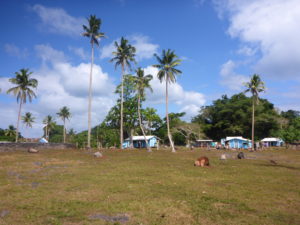
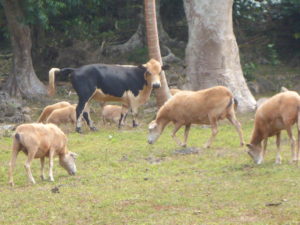
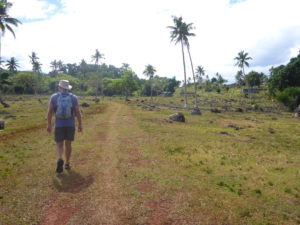
Neatly constructed dry limestone walls with five bar gates all showed a once thriving business went on here. Over a rise we met the Swiss couple, Rita and Marcel, who were exploring one hour ahead of us. They told us about a walk to the lookout where we could see over our last anchorage in Shoal Pass. A little cluster of neat blue and white huts were home to the plantation staff. We wandered past them only to be called back “Good morning” by a tall slim lady called Coto.

As Coto led us to the lookout she explained how all the huts blew apart in the cyclone and she and her family sheltered in the nearby forest for twelve hours as it howled and roared through overnight.
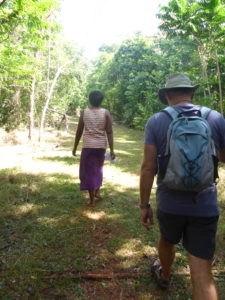


I asked her numerous closed questions and she did not expand on the ‘yes/no’ answers. I understood that the bungalow ahead on the high promontory belonged to Tony and he was in residence, but later when we met Rita and Marcel at the site of the cyclone damaged yacht club they said they had climbed right up to the bungalow and it appeared deserted.
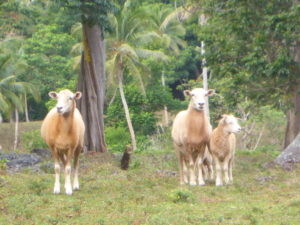
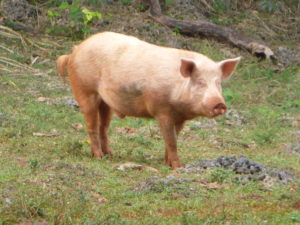
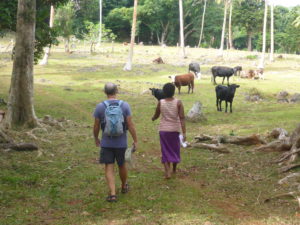
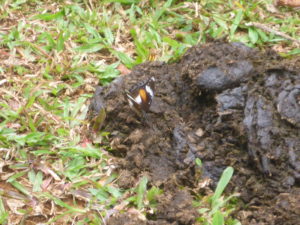
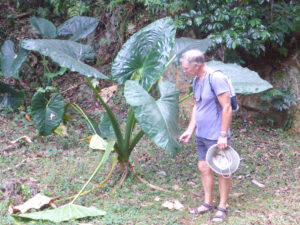
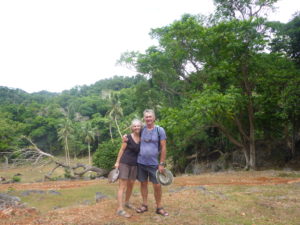
We did the same climb, leaving the dinghy at the little jetty and wandering past the club. We also got to the top to see the same bungalow we were heading towards when Coto called us back. Rita told us she had seen a bikini thrown across a chair so we wondered if they had come very close to stumbling upon the snoozing occupants, how embarrassing would that be!
On the climb back down we retrieved five papayas Rob had found on the trail, washed them in seawater and left them in the dinghy before exploring the yacht club.
Built on what appeared to be an old gunning placement with its battlement and castellation looking out over the entrance to the bay I could imagine a canon in there ready to fire at marauding Tongan Warriors entering in full battle dress in their giant Waka canoes. This did happen, it’s not just my over active imagination!
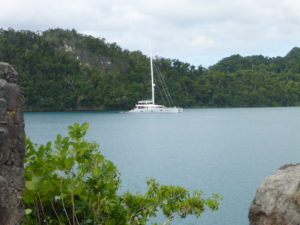
The small yacht club was built to entertain and not defend and to be honest it would take only a small investment and a few days hard work for a team to get it back into running order. The Oyster Yacht Rally visited back in 2014, two years before the devastation of cyclone Winston, so the lady we sat next to at the Oyster dinner in the OXO Building by the Thames in London back in 2015 would have been here and enjoyed the hospitality.
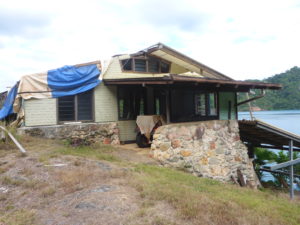
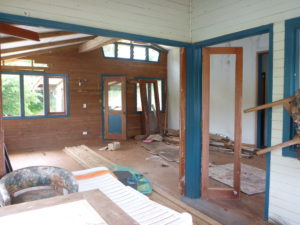
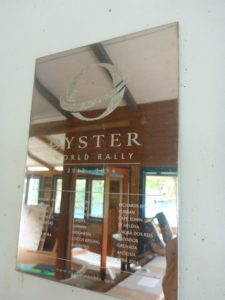
Picture the scene, twenty or so large modern Oyster sailing yachts moored safely in this lovely natural harbour surrounded by high forested limestone hills. Their crew are ashore chatting and drinking, the aroma of the BBQ feast being prepared for them whetting their appetites, all appeared well then. Then along came Winston.
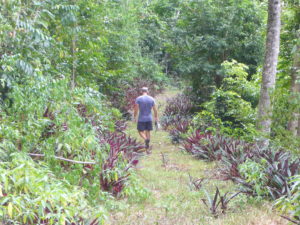

We were hot and sweaty when we returned to Zoonie and so like our naturist neighbours, whom we knew we would not take offence because they did the same, we had a nice skinny dip around Zoonie’s hull just to cool down.
That evening, over drinks on Shamal with Rita and Marcel from Zurich we chatted about the feasibility of the yacht club as a business. The location is ideal in this high sided harbour and we thought that advertised moderately this would be a perfect venue for rallies, charters and superyachts to visit and enjoy the hospitality of island life. Time will tell.
Wavelength was leaving from the tiny anchorage to the left as we entered Balavu Harbour. They were on their way to Lomaloma further down the island and we said we would join them there in a day or so. The anchorage they were in is marked as a hurricane hole, but after Winston powered around the area, even inside the high sided bay, that must have brought doubt upon the claim that a vessel would be safe there in the event of a cyclone.
I finished my Bill Bryson (1991) book, ‘Neither here nor There’ in the evening, he really is a favourite travel writer of mine second only to Cook of course. Then we watched some ‘Allo Allo’ to wind us down for sleep.
I cast a glance over my shoulder as we left this beautiful natural harbour the next morning on our two hour reef hopping motor down to Lomaloma (17:17.69S 178:58.92W). At one stage the next waypoint had us heading for the shore of a headland so I thought there must be an obstruction on the other side that we were being led around and indeed it was marked with a pole. Most of the trip though was nice deep uncluttered water. The waypoints were accurate and allowed for little deviation in places. Despite Winston there were still numerous dark posts on the reefs, and I kid you not most of them were topped with brown boobies facing in the right direction for us and pointing their beaks south.
The anchorage is in the shelter of a small island which was useful because the holding was thin sand over coral. We let out 50 metres of chain with the hope this would put enough weight overboard to hold us in the event of a blow.
Spanish Hose, from near Barcelona, joined us on Wavelength for a chat. He has a friend with him plus two other people, the woman poisoning the previously happy threesome with her unpleasant views. She also cunningly teamed up with one of them so Hose and his lady friend now have a dangerous confrontational situation on board his yacht. He told us of his plan, hopefully with the permission of the authorities he had sought to gain by telephone, to tender both of them ashore in the morning. “This is my boat” he said with a mix of desperation and determination, “it cannot go on”.
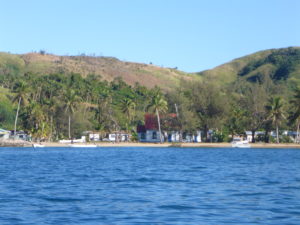
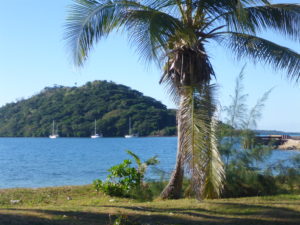
We found three shops ashore in this pretty little village backed by golden pyramid like hills the next morning; at the first shop we bought butter and two packs of oats, then the shopkeeper noted our purchase in a big thick book with the tiniest most perfect writing one would expect of a Medieval scribe.
The second shop issued forth the lovely aroma of fresh bread and in the third the shop keeper greeted us with “Good morning how are you today?” instead of the local ‘Bula’ and there we found eggs, onions and cake mix and boy was I glad of the latter when we got to sociable Fulanga.
We wandered along the shoreline track of the village with two canons mounted on concrete and plaques written in Fijian, an enticing hint of their history, and on past the hospital with its rope ‘sleeping policemen’ lying across the road, “They can’t be very effective can they Rob?” I asked.
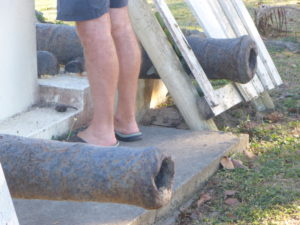

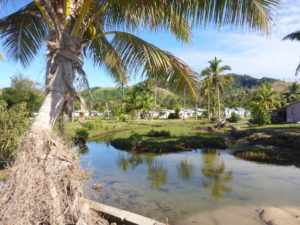
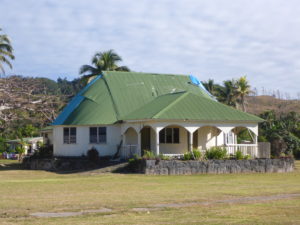
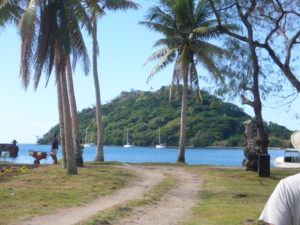

“Maybe toddlers on their trikes are a problem?” We wondered.
On the way back in our tender Hose was just setting off from the beach further down and waved an enthusiastic and jubilant wave. Standing on the shore with their bulging backpacks on were his two cantankerous crew looking rather bewildered. Hose had hopefully got through to immigration and received permission to eventually clear out of Fiji with a shortened crew list.
The winds were light for our departure as we motored out from our protective fringe reef into the 12 mile wide lagoon heading for our exit, the Tongan Passage. It was a mid-morning departure and we would be sailing overnight to arrive the next morning outside Fulanga. Two hours later we were entering the Vanua Balavu passage with Wavelength just ahead, out into nice deep water, still with a few reefs to avoid but with the freedom of the South Pacific Ocean to enjoy once more. I like deep water and space.
Easterlies blew teasingly at our three hulls, Wavelength ahead, Zoonie in the middle and Mark’s friends in their cat’ Havachat bringing up the rear at least to begin with. We were moving southward so at least the wind was not slowing us down.
The night sky was ravishing as usual and our watches were a pleasure in the cool of the night, Afghan biscuit in hand and a nice hot chocolate drink to round of perfectly our few hours of solitude. Havachat’s steaming light gradually overtook us but that was fine as we wanted the help of the sun in the morning to see the reefs alongside the channel on our way in to Fulanga.
We have received so much advice about how and when to deal with reefs and coral heads we had to sift through what was useful and what would be great in an ideal world. ‘Always have the sun behind you and high in the sky’ so what if the sun goes behind a cloud just as you want to enter and the entrance is on the south side of the lagoon? The sun can never be behind one if entering from the south. ‘It’s best to enter at slack water or on the last of the rise or fall’. We cannot have it all ways and have to make compromises. With the sun behind and of use we would be entering the passage in the last three hours of the ebb, the strongest possible tide against us. This would be interesting!
We watched Wavelength make her turn in and proceed very slowly. I took over the helm from the autopilot a mile from the start of our entry waypoints. Waves were breaking high and white over the reef which extended as an arm out to sea on the left side of the passage, scooping us into the turbulent water.
Fortunately Mark had radioed to tell us about the disturbed water which extended for a quarter mile or so and was caused by there being two passages from the lagoon that met at the entrance to the main passage. With two volumes of water exiting at the same time and place there was going to be a maelstrom of water for Zoonie to push through before we could move up the pass.
It was midday so we ticked one of the boxes, the sun was high. The maelstrom swirled and leaped around like a whirling dervish and played ping pong with Zoonie’s hull and rudder, one minute swinging her bows towards the angry reef on one side and then the other. The vast surface area of the reef was a kind of tooth decay yellow I noticed as Zoonie pointed in entirely a direction I was not happy with. I wrestled with the wheel trying to at least keep her equidistant from each side of the 50 metre wide gap and after a few minutes we were past the pass meeting place and into the main passage. Phew, I thought it would be plain sailing from here but no, a quick look at the stationary reef and then the speedometer and we also were almost stationary. Our speed was slowed from 5.4 knots to 1.1 by the outpouring tide. So it was up revs to over 2000rpm so we could crawl over the powerful ebb and no doubt burn some carbon off at the same time.


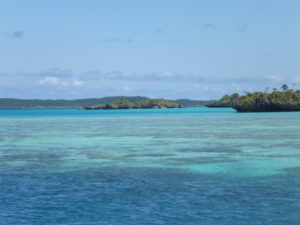
We had it easy, there are sometimes standing waves at this point, especially with an ebb and a strong contrary wind. But I was glad when we were through all the same.
Navigating by waypoints is just like the children’s game ‘Join the Dots’ and Rob on the foredeck was playing ‘Spot the Difference’ between the different shades of water to detect nasty coral heads (they’re not really nasty, in fact they are beautiful, but you know what I mean). Overall dark water is good but lighter water with dark areas means there is a head down there and of course we don’t know how deep it is without moving right over it so the depth transducer can read its depth, but that would be a hard way to find out it wasn’t deep enough. So avoidance is crucial.
Safely through the passage we had a couple of miles to go to the village anchorage a Muana I Cake (thake). The way points were so close I turned the IPad around so instead of north up which meant Zoonie’s progress was in reverse and I had to mentally work out which way to turn the wheel at every turn and of course this takes time. With ‘head up’ I had Zoonie’s chart plotter picture going the same way as we were heading. Much easier. If we did a ‘u’ turn at any time of course I had to turn the Pad around again. Folk who have chartplotters in their cockpit can do that alteration at the press of a button.
By comparison to the intimacy of Shoal Pass Fulanga Lagoon is vast with acres of the most beautiful grades of blue and turquoise water dotted with little palm tree decorated islets with overhangs above the water where waves have eroded the limestone over millions of years.
Wavelength took herself off to a different anchorage but we were in the company of Havachat. How brilliant a name is Havachat? Bought in France by Peter and Martina who jokes that Peter talks a lot, along with the double meaning of chat being French for cat and the vessel being a catamaran. I was impressed and told them so.
That evening Rob and I celebrated our arrival in one of the most beautiful spots on the face of the planet by continuing our voyage through the 84 episodes of ‘Allo Allo’ a mid-eighties to early nineties TV comedy about Renee who runs his French Café with his wife Edith when the local Resistance led by Michelle (“Listen very carefully I will say this only wence”) were trying to re-patriate two hapless English airmen under the gaze of the Germans and Gestapo. Many unlikely attempts are made but they all fail magnificently and Renee has to hide the airmen all over his premises while secretly promising marriage to both his waitresses, spluttering Maria and luscious Eve and later Mimi.
Sometimes Edith catches them in compromising embraces and when she questions Renee he is thinking up his excuse which always includes “You stupid woman”. For us a harmless distraction which is all the better for a second viewing to study the clever script, irony (Renee the bounder is gay in real life) double entendres and the theatrical detail along with the superb gentle British humour. No offense is directed at any of the groups, Gestapo, Germans, French, English or French Resistance which is why it is popular globally including in Germany.
Fulanga – A World Apart
19:08.97S 178:33.91W
The Old Chief is Dead – Long Live the Chief
They don’t know who he is yet as he will be chosen by the clan elders of the family within the village sometime after the initial mourning period of bakabogidrau (one hundred nights) is over. The old chief, Taniela Bese who ruled from 1999 until his death a month before our arrival succeeded an isolationist leader who banned cruisers from visiting the island.
However Taniela Bese could see that there were mutual benefits from welcoming us lot. Our visits are without religious, political, land grabbing or commercial elements. We bring no disease (hopefully) and need only friendship and enlightenment and any fruit and veg they would like to sell to us. With that money they pay for the electricity to light long life bulbs in their homes so they can enjoy an evening life, usually of kava drinking, thus lengthening their days and enriching their quality of life and sometimes frustrating mums who have to get the children up for school the next morning.
Each cruising yacht pays $50 at their sevusevu which goes into a fund to benefit all the villages on the island. The fund is drawn on to finance official travel business expenses to Suva of the chief and his assistant, school needs and church requirements.
The villagers ask little of the government and if they need expensive items for their homes (each house has at least two solar panels) or for the school then they have fund raising events to bring in villagers and visitors who love to buy their fabulous carvings and weavings and naturally organic fruit and veg.
However out of all of this union there comes also the richness of mutual generosity and affection. Many New Zealand and Australian cruisers return year after year to their village friends here and I envied them their geographic location enabling them to do just this, return. Just think the villagers had none of that before the last chief came into office.
We needed to get ashore and present ourselves for sevusevu, the official welcome to the island at which we are given permission to explore to our hearts’ content.
Tai and some other villagers met us, all introducing themselves with a warm handshake and a “Pleased to meet you, what is your name?” Grey haired Tai was taking some of the younger generation of men out to a distant island across the lagoon for a day of cassava planting on a patch of good soil. The cassava root is boiled like potato and adds starch to their diet. It is also yummy if sliced after boiling and fried into chips.
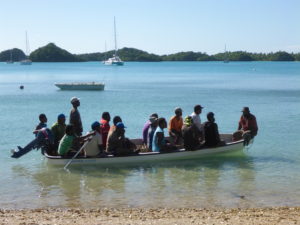
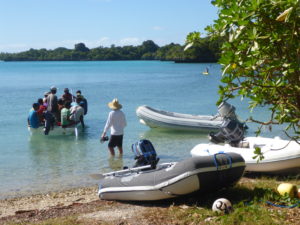
Tai presented to us Bill, Taniela’s grandson and a man of late thirties early forties who is never far from the next joke. He came across from Suva in February to join the family team in looking after the old chief who was in his mid-nineties and failing fast. Bill led the way up the narrow, foot smoothed path talking as we went. He was looking forward to the end of the bakabogidrau so he could shave off his hair and beard and wear anything but black, as it attracts the wretched mosquitoes, scratch, slap!
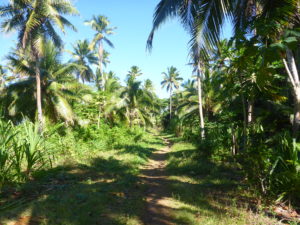
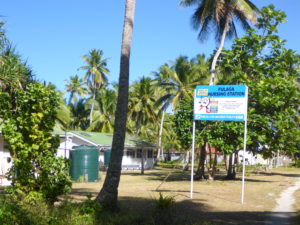
He loved his grandfather who raised him in Suva after his parents separated and his mum, Tara returned to the village, but he was used to the city ways and appeared keen to return to Suva.
Tame swiflets swooped around our heads as we approached the village and removed our sunhats as required by custom. We both wore long trousers and covered our shoulders, also part of the custom of respectability. Far to the left the ocean thundered against the reef and the ocean water was an astounding blue, competing with the sky for beauty. Just back from the beach in the shade of palm trees a loose row of homes had the best ocean views. “Bulas” came from all around especially children who would come up to us and reach to shake hands with “What is your name?” Theirs were the likes of Isabella and Eleanor, James and Jone.
The door to the medical centre was open and the nurse in her pristine white uniform strode off, medical bag in hand, on her errands.
Bill introduced us to the ladies in one house enjoying their weekly weaving session. Only women make the beautifully precise parchment coloured pandanus mats and it is an ongoing job since they are exported to Suva and further as well as being a part of every village home. They are cool and clean to sit on, as chairs and tables are rare and sitting on the floor puts the seated in the direct cool draft through the open doors. Also the mats last for years.
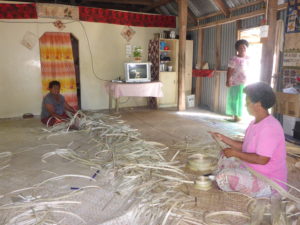

Outside the whole process of cutting the pandanus leaves, laying them out in the sun to dry and then weaving them into baskets was underway with groups of ladies sitting in the shade of makeshift canopies and chatting and laughing together.


Mark and Teri had already arrived by a different track from their anchorage and were enjoying their sevusevu with Mika the temporary chief and nephew of Taniela Bese so we stood in the shade of a breadfruit tree awaiting our turn and chatting with Bill who had donned a Sulu or sarong for the formal meeting.
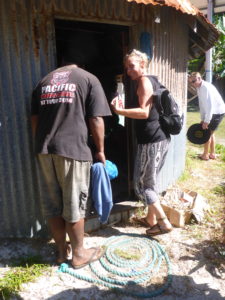
We were invited to join the threesome inside the neat hut and sat cross legged facing Mika. They spoke some Fijian and Bill handed Mika our $50, the kava and our ships papers and cruising permit. The last two items are not usually required but a few weeks ago a local fisherman found a big stash of cannabis buried in the sand above an anchorage, took it to the village where the police and customs were advised and two yachts were impounded and their crews were arrested.
I filled in the visitors’ book to find we were the 52nd visiting yacht this year, quite appropriate I thought as my birthday was the next day and I was born in 1952.
Formalities over, Mika could get back to his chores while Bill introduced us to our host family, Mere (a teacher in the kindergarten school with 13 in her class,) and her husband the drop dead handsome Jone, a wood carver of great talent. (matai = skilled carver)
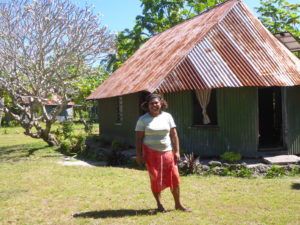
“This is ‘Madame Speaker’ (Bill’s nickname for Mere) who is so happy to be your host for your stay here. Now that your sevusevu is done you are free to move around the island and village, take photos and fish if you wish, you are very welcome always.”
“You must believe less than one percent of what Bill says” Mere joked and the friendly banter between the two is ongoing. Poor Mere, we hadn’t announced our arrival in advance so Mere only learned she was hosting us about 10 minutes before we arrived. She is a volunteer host so she didn’t mind but it meant she hadn’t had any time to prepare food. She is not paid for her hospitality.
Mark and Teri’s host is So, Jone’s older sister. As you can imagine there are family connections throughout the village which is divided into four clan groups, must have been some Scottish influence at some time in the past.
There are 80 villagers here and two other villages on the island. All the children attend the school here in Moana I Cake (I cake = above) for their first year. Mere and Jone’s daughter is now at school in the capital, Suva on the main island Viti Levu two hundred miles away. She lives with Mere’s sister and is missed greatly by her mum. Mere’s parents live on their farm in the hills behind Suva but visiting them by the once a month supply ship is prohibitively expensive, $119 each way (it was $135 until recently) and then one has to pay extra for luggage and supply one’s own food and bedding for the night passage and of course stay a month until the next supply ship voyage and the same expense again. So they see their mainland family once a year, the same as us when we travel across the world and they travel across the Koro Sea.
But Mere (Mary) chooses to live the island life, “Every day in the city we have to earn a lot of money and everything costs money, always there is this pressure. The city doesn’t compare with the peace and beauty here. I like the sense of community where we all look out for eachother.”
Their food is growing just outside the door in the trees, in the ground or squeaking and snorting in pens, or in the water (surf and turf) and there is plenty of it and a good variety. What they don’t grow, rice, flour, sugar, custard powder etc they order at the little shop and collect and pay for when the long awaited supply ship arrives.
Mere’s government salary for her teaching has been increased to match a male teacher’s salary by the military government that is in office. They have also made education free. Despite those two improvements for her personally, Mere will vote labour at the coming election maybe in a desire for civil harmony, I didn’t want to probe too deeply.
Fiji has historically had a military government on occasion when the tensions between the Indian population and Fijian residents have risen to levels that threaten peace on the main islands. Despite being the capital Suva has been the scene of violent protest many times in the past.
Mere stepped out for a few moments to pick some lemongrass, scrunch it up and pop it into a jug. She then filled this with water she had boiled earlier and stored in a thermal flask. We sat cross legged chatting and enjoying fresh lemongrass tea and coconut milk bread made in the same early hours as the water. The birds sang in the trees and the scent of the frangipani blossoms filled the room from the tree just outside one of the three doors. The house has attractive bowed ends to offer little resistance to cyclone winds and the bigger of the two rooms which we were in was about three quarters of the entire home and around 6 metres by 4 metres in size.
The corrugated tin walls are draped with colourful cotton hangings and supported with six stout round tree trunks, which double as comfortable back- rests. Mere cooks on two cookers, one a gas oven with hobs and the other a single, much hotter primus stove. Away from the house is a little shed with a proper toilet and lots of containers of rainwater where they have hand showers. Washing up is in a bowl on a bench just outside the house and clothes washing is done by soaking in a large container, just as I do. There is no need for a fridge as food is taken fresh daily and cooked to preserve it. This way all the families have a constant supply of cooked food ready for their meals.
Bill wandered in and asked if we would like to see one of their numerous vegetable gardens. “He is a city boy, he knows nothing about plants only what Tui told him yesterday,” Mere joked.
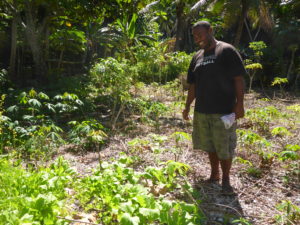
Peter and Martina from Havachat joined us and Bill showed us the red stemmed cassava saplings planted in neat rows at an angle to the ground, taro plants that grow everywhere in the south Pacific islands, self-sown wasabi leaves (horseradish) which are edible raw and Martina had a ball chomping away on one of her favourite leaves. Usually they boil them and then replace the water with home-made coconut milk, delish.
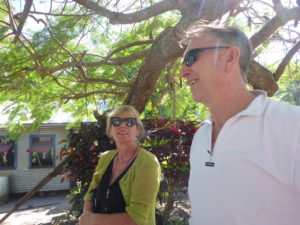
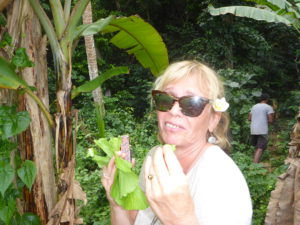
Coconut and banana palms swayed in the breeze above us and papayas and breadfruit were in abundance on their trees. Zu wove us baskets from green pandanus leaves and filled them with a variety of produce for us three groups of cruisers.
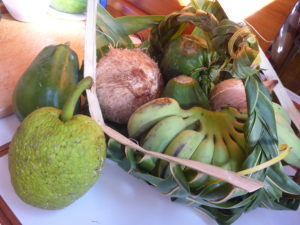
Then we were all invited to take kava with the ladies and a young man hosted the mixing of the crushed kava inside a fabric bag with fresh water he poured into the big vesi wood bowl (Tanoa) that had been made by one of the village wood carvers. An elder whose name eludes me sat and watched to make sure the mixing was in the correct portions. “High tide, low tide or medium tide?” we were asked meaning how full did we want our half coconut cups (Bilo) to be on each round.
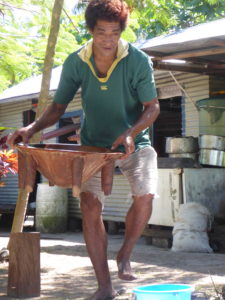
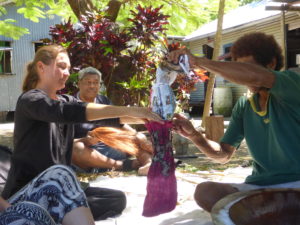
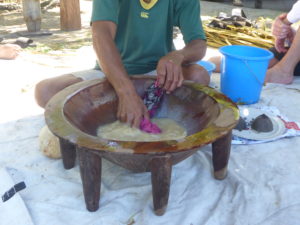
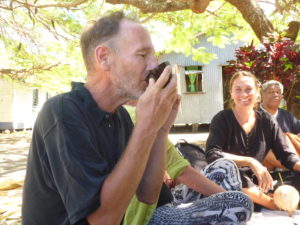

We would get used to the dry slightly aniseed, peppery taste that on the third round or so leaves a tingly sense on the lips and a numbing in the throat, but today I made visitors and villagers laugh when I pulled a screwed up expression on the first round. “Oh dear Barb, you’ll get used to it.” Mark said. Everyone is affected with varying amounts of the drink which has ‘mildly sedative and anaesthetic properties’, unquote the guide book. We felt no such effects!
So (Mere’s sister in law) entertained us for lunch, the six of us sitting cross-legged and feasting on pumpkin and tuna curry and rice made by her teenage daughter, Bellina. It was a well-rounded mellow curry, very easy to eat and we complimented the young chef. “All those mugs So and piles of plates, why so many?” I asked.
“Sometimes all the villagers come here and eat,” she replied. No wonder Bellina is learning how to cook and no wonder the villagers all come!
